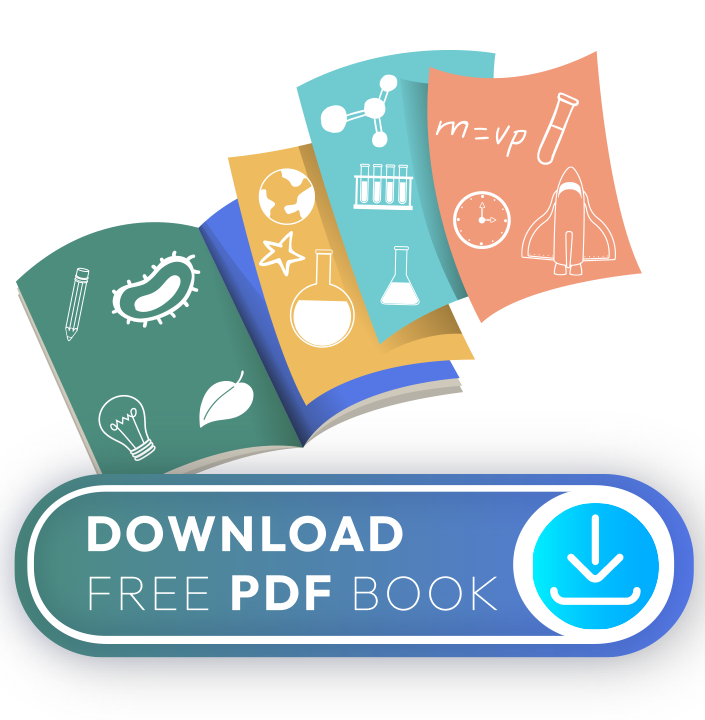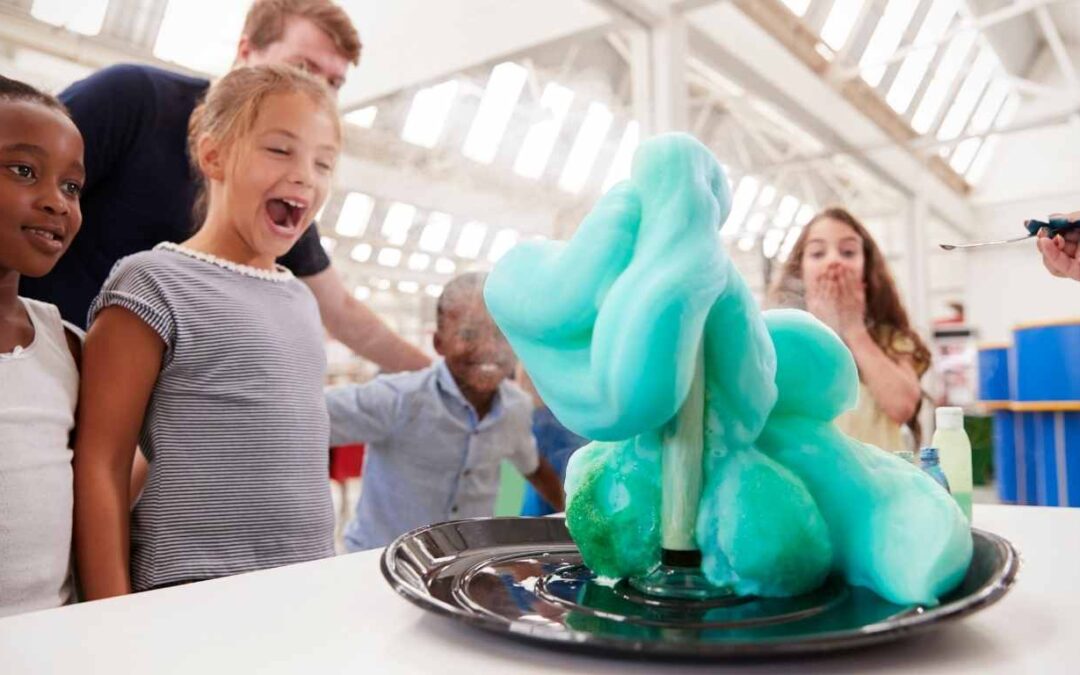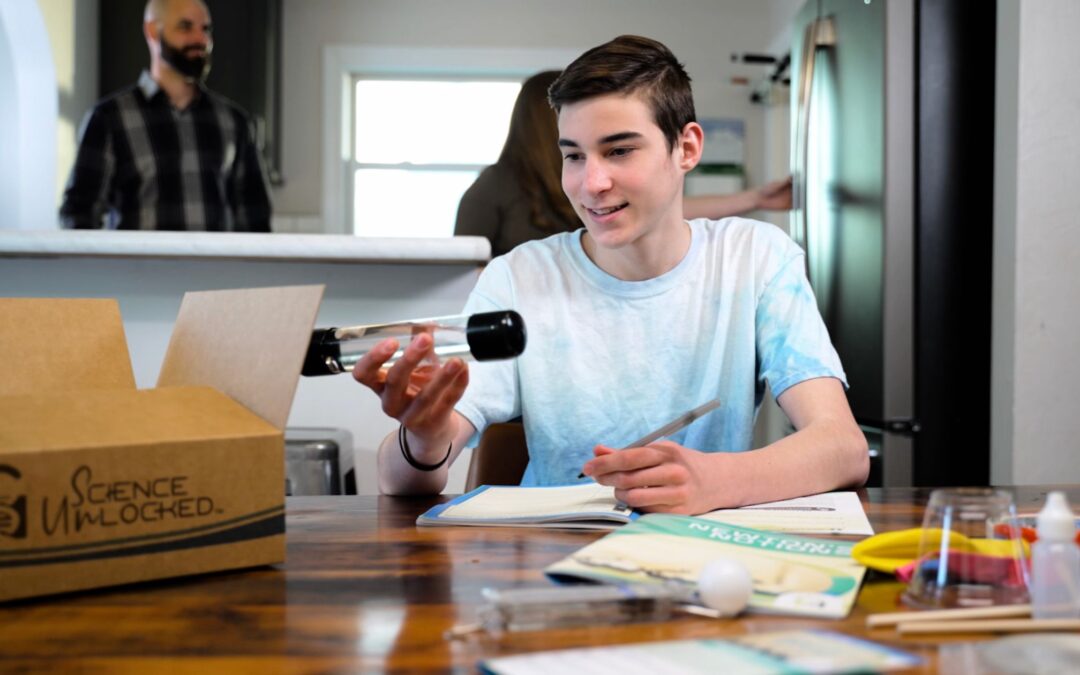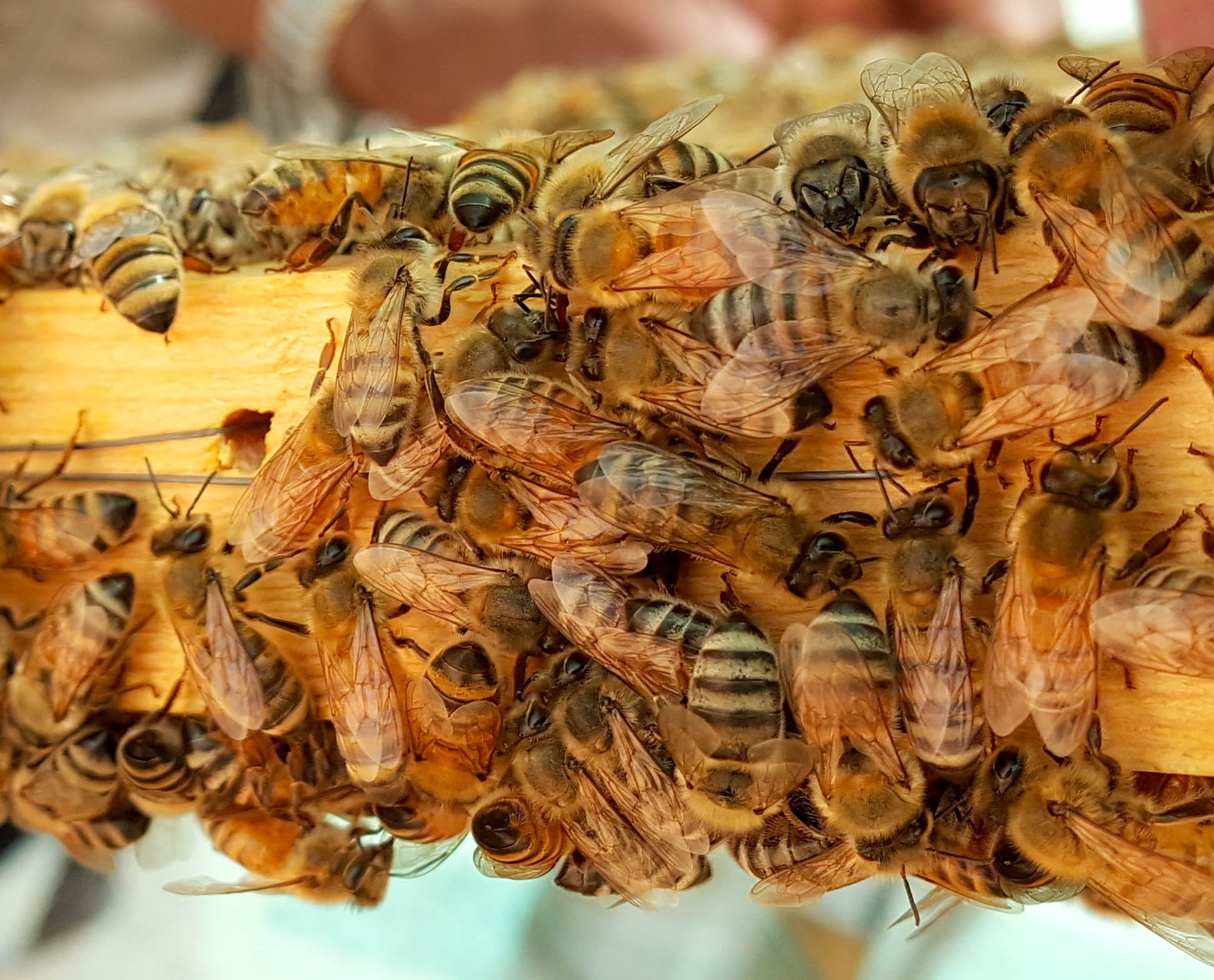Pinwheel Wind Turbine
Make a pinwheel to see how a very basic turbine works, and then use it to create electricity!
If you don’t have the electrical components, you can still do the first part of this project to see how wind can create mechanical force.
>> Use this pinwheel pattern (PDF) to build your turbine.
What You Need:
- Cardstock
- Pencil with eraser
- Straight pin or thumbtack
- Small electric motor (can find at a hobby store)
- Alligator clip leads or insulated copper wire
- 1.5-volt bulb and bulb holder (you can also find these at a hobby or hardware store)
- Strong fan (standing or box fan)
What You Do:
Part 1 – Pinwheel
1. Cut a piece of cardstock into a 4′ square. (If you’re only doing this part of the project, you can make it bigger if you like.) Look at the pinwheel pattern to do the following steps.
2. Use a ruler to draw diagonal lines from corner to corner. Make a small mark along each line 3/4 of an inch from the center of the square.
3. Cut along the diagonal lines toward the center until you reach the 3/4-inch mark.
4. Fold the corners marked with circles on the pattern into the center and staple the layers together. (You’ll probably need to use at least two staples, but make sure to leave space between staples in the very center). When all four ‘blades’ are folded in, stick a straight pin or thumbtack through all the layers at the center. Push the pin through the eraser on the pencil to finish the pinwheel.
5. Hold the pinwheel in front of a fan and watch it spin. The currents of air coming from the fan catch the curved part of the blades, causing them to spin.
Part 2 – Generator
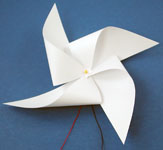 1. Remove the pinwheel from the pencil and punch the shaft of the motor through the center. (Try putting a couple strips of masking tape on the back of the pinwheel before you punch it through – this will make a tighter fit on the motor shaft.) If your motor came with a little cap for the end of the shaft, put that on to hold the pinwheel in place. If you don’t have a cap, use a piece of clay or cork.
1. Remove the pinwheel from the pencil and punch the shaft of the motor through the center. (Try putting a couple strips of masking tape on the back of the pinwheel before you punch it through – this will make a tighter fit on the motor shaft.) If your motor came with a little cap for the end of the shaft, put that on to hold the pinwheel in place. If you don’t have a cap, use a piece of clay or cork.
2. Use the alligator clip leads to connect the motors wires to the light bulb.
3. Now hold the motor/pinwheel close in front of the fan again. Does the bulb light up? Look closely – you should at least see the filament begin to glow. The brightness of the bulb will depend on how much voltage your turbine is producing, which can change with the size of the pinwheel and the strength of the fan.
What Happened:
When you attached the motor to the pinwheel and put it in front of the fan, you transformed the motor into a generator, which converts mechanical force (the spinning of the pinwheel) to electricity. It does this with the help of a magnet inside the motor. When you connected the wires of the motor to the light bulb, you made a complete electrical circuit, allowing the electricity to flow from the motor through the bulb and back again.
One way to measure power is in volts. A volt measures the amount of electricity flowing through a circuit. The faster a generator spins, the more volts it will produce. With our simple wind turbine, a smaller pinwheel will produce more volts because it can spin faster. To fully power the bulb, your turbine would need to produce 1.5 volts. If the bulb just glows dimly, it means the turbine is producing less than 1.5 volts.
Real wind turbines have very large blades, so they have gear boxes that increase the rotational speed (how fast the shaft spins). For example, the main shaft might turn only 22 times per minute, but the gears in the gearbox can use that power to make a smaller shaft turn up to 1500 times per minute, creating a lot more voltage!
More experimentation: If you have a digital multimeter, you can measure the amount of voltage and current (amps) produced by your mini turbine. Experiment with larger or smaller pinwheels, or make individual blades like a modern wind turbine. Which design can produce the most voltage? Which produces the most amperage? When would you want more amps and when would you want more volts? What size of pinwheel causes the light bulb to glow the brightest? Can you use your turbine to power another motor? To lift weights?
| Recommended Product Wind Turbine Kit 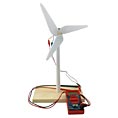 Build a sturdy, free-standing wind turbine with a plastic base and take your experimenting to new levels! You’ll be able to test the power of your blade designs with the digital multimeter, store wind energy for later use with the super capacitor, and experiment with series and parallel circuits using two motors and three LEDs. Includes instructions for seven experiments plus four different patterns for turbine blades. Ages 12 & up. Build a sturdy, free-standing wind turbine with a plastic base and take your experimenting to new levels! You’ll be able to test the power of your blade designs with the digital multimeter, store wind energy for later use with the super capacitor, and experiment with series and parallel circuits using two motors and three LEDs. Includes instructions for seven experiments plus four different patterns for turbine blades. Ages 12 & up. |
Wind Energy
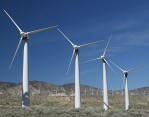 Strange as it may seem, wind energy comes from that ultimate power source, the sun.
Strange as it may seem, wind energy comes from that ultimate power source, the sun.
(In fact, almost all sources of energy originate with the sun!)
As the sun shines on the surface of the earth, it heats the land faster than the oceans. The warm air above the land rises, and when it does so cooler air from over the water rushes in to take its place—this is wind!
Meanwhile, the rising hot air cools and descends back down over the water. This air circulation is called convection. You may wonder how you have wind in your area if you don’t live by the ocean.
Convection is happening on a huge scale throughout Earth’s atmosphere, so it doesn’t just affect the coasts.
Wind is a form of kinetic energy, meaning that it is in motion. For centuries people have used windmills to harness that moving energy into a mechanical form to perform tasks such as grinding grain or pumping water.
In our society we mostly use energy in the form of electricity, so modern wind turbines are designed to produce electricity that can be fed into the local power grid.
Wind turbines have three main parts:
- Tower: Built on a sturdy foundation, a wind turbine’s tower may stand well above 100 feet tall. At that height the wind is likely stronger and more consistent, since it is not being deflected by trees and buildings. Also, the height prevents the blades from being a danger to livestock or other animals.
- Rotor: A modern wind turbine generally has three long, streamlined blades which together are called the rotor. The diameter of the rotor is sometimes more than 250 feet, almost enough to cover a football field when lying on the ground!
- Nacelle: The rotor is attached to the nacelle, which houses all the components that convert the motion of the wind to electricity—such as the generator, gearbox, and controller.
While a single wind turbine can produce quite a bit of power, turbines are often built in groups, called wind farms. These are built in windy areas, usually open flat plains or exposed ridges.
Since wind energy is a renewable resource and does not produce any pollution, it is a good alternative to fossil fuels.
A wind turbine can produce enough electricity in about 6 months to recover the amount of energy used in building it, although it takes much longer than that to pay for itself.
In the US, the production of electricity by wind is increasing by up to 50% per year, as more wind farms are built. Countries like Denmark are producing close to 20% of their electricity needs from wind power.
While wind energy is a great supplemental energy, it is unlikely to become a primary energy source due to limitations on where turbines can be built and the unpredictability of wind.
More Alternative Energy Projects:
- Build a Water Wheel
- Weather Experiments (Including creating a convection current and making a sea breeze!)
- Build a Solar Oven

